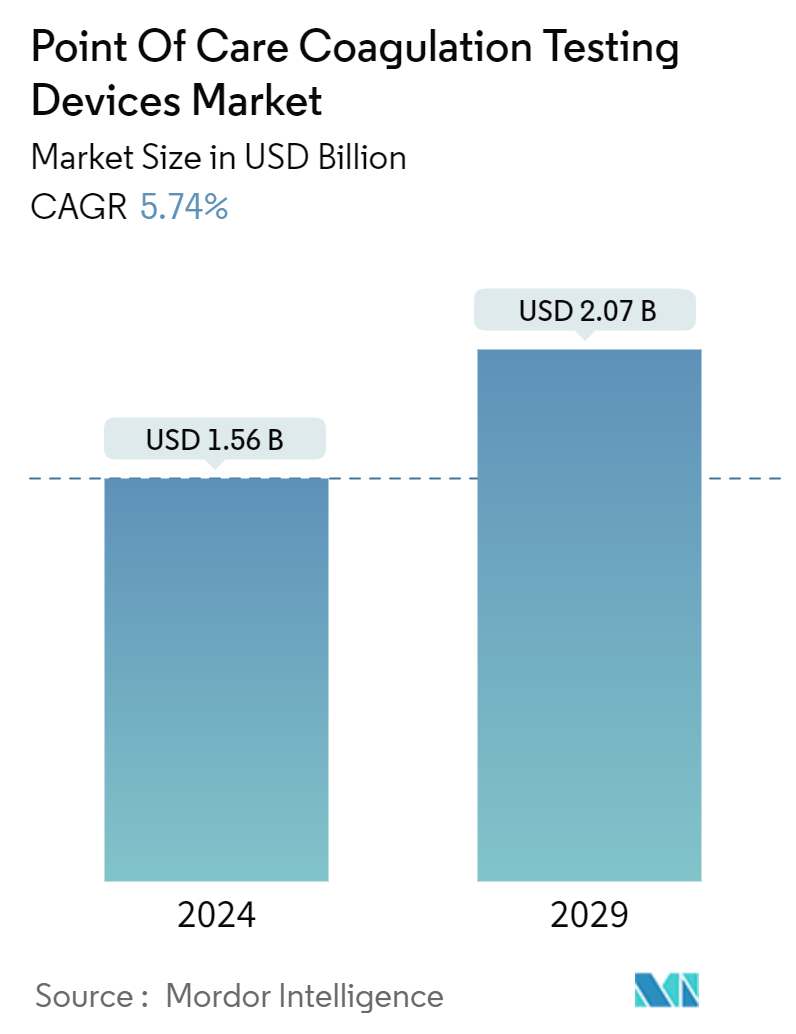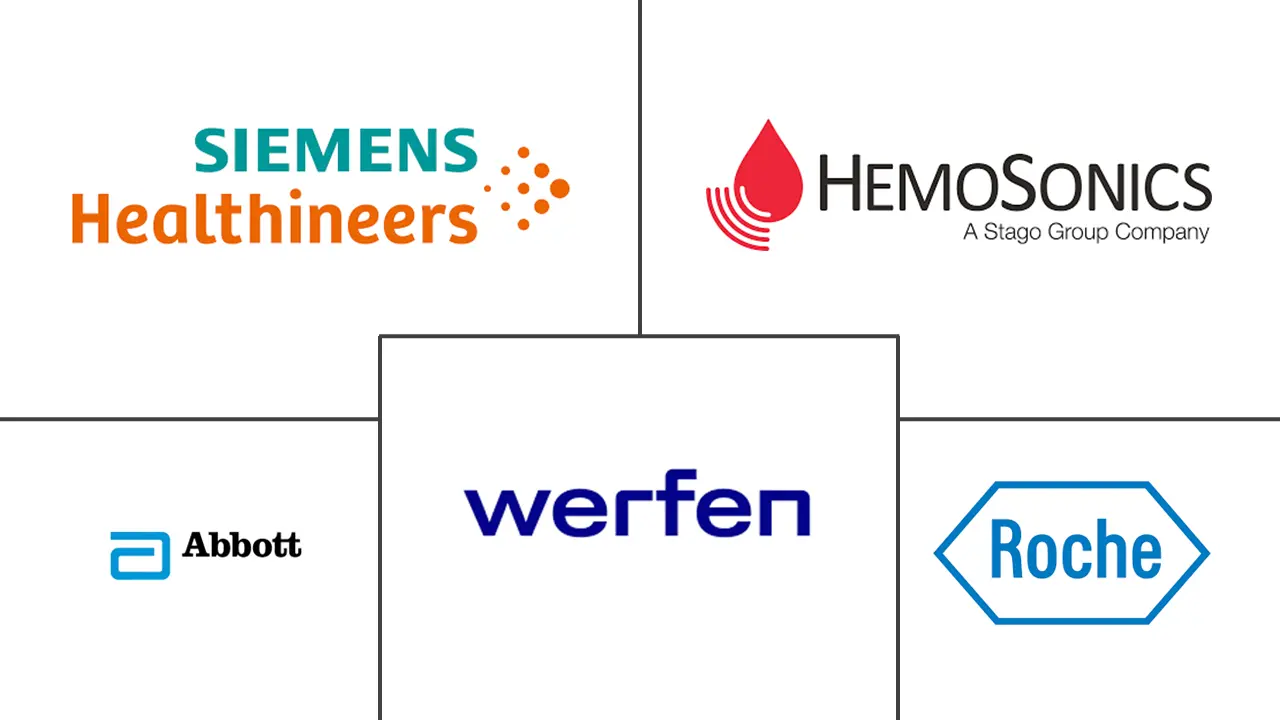Market Size of Point Of Care Coagulation Testing Devices Industry

| Study Period | 2019 - 2029 |
| Market Size (2024) | USD 1.56 Billion |
| Market Size (2029) | USD 2.07 Billion |
| CAGR (2024 - 2029) | 5.74 % |
| Fastest Growing Market | Asia Pacific |
| Largest Market | North America |
Major Players
*Disclaimer: Major Players sorted in no particular order |
Point Of Care Coagulation Testing Devices Market Analysis
The Point Of Care Coagulation Testing Devices Market size is estimated at USD 1.56 billion in 2024, and is expected to reach USD 2.07 billion by 2029, growing at a CAGR of 5.74% during the forecast period (2024-2029).
Point of care coagulation testing devices are used to measure the clotting time of patients with bleeding disorders. The demand for these devices is attributed to the increasing prevalence of bleeding disorders. According to a study published by the American Society of Hematology in November 2023, among a 1,019-patient population, 235 patients, which is 23%, were diagnosed with bleeding disorders, of which 37% were women. In addition, as per the World Federation of Hemophilia's December 2022 update, hemophilia is considered a rare disease, and 21 in 100,000 males have hemophilia A, whereas 4 in 100,000 males have hemophilia B. The increase in the patient population with bleeding disorders is surging the demand for routine anticoagulation monitoring, which is one of the significant factors influencing market growth. An increase in demand for coagulation tests is expected to boost the demand for point of care coagulation testing devices, thereby driving market growth.
Furthermore, the benefits offered by these devices over conventional testing fuel the market growth. The turnaround is fast compared to laboratory-based testing, reducing the treatment time. At the point of care, these devices offer real-time visual displays of clots and reduce non-evidence-based transfusion.
Moreover, technologically advanced products introduced by market players provide rapid assessment and high sensitivity toward specific blood components to determine the overall coagulation status of patients. According to a study published by the Saudia Journal of Anesthesia in March 2023, the point of care thromboelastography (TEG) and thromboelastometry (ROTEM) reduced morbidity rates among patients with primary postpartum hemorrhage. Moreover, the utility of TEG and ROTEM warranted long-term survival and cost-benefit in patients. Hence, such technological advancements in the devices are projected to drive market growth over the next five years.
In addition, governments globally prioritize early detection of blood-related diseases to reduce the healthcare burden, leading to a surge in initiatives, including funding, policies, and awareness campaigns. For instance, in February 2024, the Red Tie Campaign was organized by the National Bleeding Disorders Foundation in the United States to advance the fight against inheritable bleeding disorders by raising funds for research, education, and advocacy initiatives. Thus, such initiatives to improve the diagnosis rate for bleeding disorders are anticipated to surge the demand for point of care coagulation testing devices, leading to market growth.
However, factors such as the high cost of point of care coagulation testing devices, lack of skilled professionals, and low accessibility in low-income countries restrain the market growth.
Point Of Care Coagulation Testing Devices Industry Segmentation
Point of care coagulation testing devices perform multiple coagulation tests and provide insights related to the patient's clotting status. These tests are essential for evaluating and monitoring patients with bleeding disorders. These devices offer timely results by reducing turnaround time and decreasing treatment time.
The point of care coagulation testing devices market is segmented into type, test type, end-user, and geography. By type, the market is segmented into instruments and consumables. By test type, the market is segmented into anticoagulation testing, platelet function test, viscoelastic testing, and others. By end-user, the market is segmented into hospitals, diagnostic centers, and other end-users. By geography, the market is segmented into North America, Europe, Asia-Pacific, South America, and Middle East and Africa. The report also offers the market size and forecasts for 17 countries across the region. The report offers the value (in USD) for the above segments.
| By Type | |
| Instruments | |
| Consumables |
| By Test Type | |
| Anticoagulation Testing | |
| Platelet Function Test | |
| Viscoelastic Testing | |
| Others |
| By End User | |
| Hospitals | |
| Diagnostic Centers | |
| Others |
| Geography | ||||||||
| ||||||||
| ||||||||
| ||||||||
| ||||||||
|
Point Of Care Coagulation Testing Devices Market Size Summary
The point of care coagulation testing devices market is poised for significant growth, driven by the increasing prevalence of bleeding disorders and the rising demand for routine anticoagulation monitoring. These devices, which offer rapid and real-time assessments of clotting times, are becoming essential in managing conditions such as hemophilia and other coagulation disorders. The market is further bolstered by technological advancements that enhance the sensitivity and specificity of tests, providing comprehensive evaluations of blood coagulation status. Government initiatives and awareness campaigns aimed at early detection and management of blood-related diseases are also contributing to the market's expansion, as they encourage the adoption of these advanced testing solutions.
North America is expected to lead the market due to its developed healthcare infrastructure, a high patient population with bleeding disorders, and active government and organizational initiatives. The region's market growth is supported by strategic partnerships and product launches by key players, which are expanding their geographical presence and enhancing access to coagulation testing devices. Despite challenges such as high costs and limited accessibility in low-income areas, the market remains consolidated with major players like F. Hoffmann-La Roche Ltd, Siemens Healthineers AG, and Abbott dominating the landscape. These companies are continuously innovating and expanding their offerings to meet the growing demand for point of care coagulation testing devices, ensuring sustained market growth over the forecast period.
Point Of Care Coagulation Testing Devices Market Size - Table of Contents
-
1. MARKET DYNAMICS
-
1.1 Market Overview
-
1.2 Market Drivers
-
1.2.1 Increasing Patient Population with Bleeding Disorders
-
1.2.2 Benefits Offered Over Conventional Testing
-
-
1.3 Market Restraints
-
1.3.1 Expensive Compared to Conventional Testing
-
-
1.4 Porter's Five Forces Analysis
-
1.4.1 Threat of New Entrants
-
1.4.2 Bargaining Power of Buyers/Consumers
-
1.4.3 Bargaining Power of Suppliers
-
1.4.4 Threat of Substitute Products
-
1.4.5 Intensity of Competitive Rivalry
-
-
-
2. MARKET SEGMENTATION (Market Size by Value - USD)
-
2.1 By Type
-
2.1.1 Instruments
-
2.1.2 Consumables
-
-
2.2 By Test Type
-
2.2.1 Anticoagulation Testing
-
2.2.2 Platelet Function Test
-
2.2.3 Viscoelastic Testing
-
2.2.4 Others
-
-
2.3 By End User
-
2.3.1 Hospitals
-
2.3.2 Diagnostic Centers
-
2.3.3 Others
-
-
2.4 Geography
-
2.4.1 North America
-
2.4.1.1 United States
-
2.4.1.2 Canada
-
2.4.1.3 Mexico
-
-
2.4.2 Europe
-
2.4.2.1 Germany
-
2.4.2.2 United Kingdom
-
2.4.2.3 France
-
2.4.2.4 Italy
-
2.4.2.5 Spain
-
2.4.2.6 Rest of Europe
-
-
2.4.3 Asia-Pacific
-
2.4.3.1 China
-
2.4.3.2 Japan
-
2.4.3.3 India
-
2.4.3.4 Australia
-
2.4.3.5 South Korea
-
2.4.3.6 Rest of Asia-Pacific
-
-
2.4.4 Middle East and Africa
-
2.4.4.1 GCC
-
2.4.4.2 South Africa
-
2.4.4.3 Rest of Middle East and Africa
-
-
2.4.5 South America
-
2.4.5.1 Brazil
-
2.4.5.2 Argentina
-
2.4.5.3 Rest of South America
-
-
-
Point Of Care Coagulation Testing Devices Market Size FAQs
How big is the Point Of Care Coagulation Testing Devices Market?
The Point Of Care Coagulation Testing Devices Market size is expected to reach USD 1.56 billion in 2024 and grow at a CAGR of 5.74% to reach USD 2.07 billion by 2029.
What is the current Point Of Care Coagulation Testing Devices Market size?
In 2024, the Point Of Care Coagulation Testing Devices Market size is expected to reach USD 1.56 billion.

